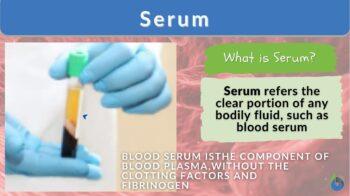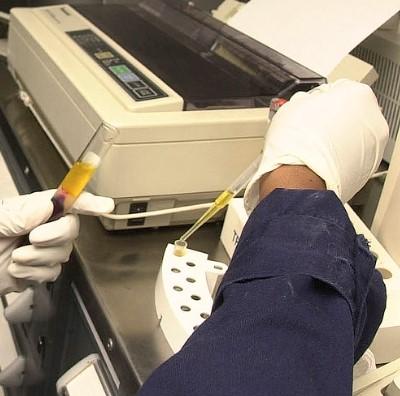
Serum
n., plural: sera, serums
[ˈsɪəɹəm]
Definition: clear, watery component of the bodily fluid
Table of Contents
Serum Definition
In biology, serum generally refers to the clear portion of any bodily fluid of animals and plants. Examples are the blood serum, serous (or serosal) fluid secreted by the serous glands, and plant sap. Nevertheless, the word serum is more commonly associated with blood serum, the clear, pale-yellow liquid derived from the blood and is devoid of blood cells and clotting factors.
Etymology: the word serum (noun), from the Latin serum for “whey”
Related forms: serumal (adjective, of, relating to, pertaining to, or characterized by serum)
Examples of Biological Serums
Blood Serum
Blood is made up of plasma, blood cells, and platelets. Plasma, in turn, consists of substances such as metabolic wastes, nutrients, hormones, and proteins such as clotting factors, bilirubin, albumin, globulin, and fibrinogen. When the clotting factors are removed from the plasma, the clear, the clear watery fluid that remains is called “blood serum”. Nevertheless, many of the solid and liquid components in the blood plasma are the same components of the blood serum.

Here is the summary of the differences between plasma and serum:
Plasma vs. Serum | ||
|---|---|---|
| Features | Plasma | Serum |
| Definition | Plasma is the clear yellowish fluid obtained from the blood sample. It is the blood component where blood cells are suspended. | The clear, watery fluid component of blood plasma |
| Density | ~1.03 g mL-1 | ~1.02 g mL-1 |
| Contains blood cells and platelets? | no | no |
| Contains clotting factors? | yes | no |
| Contains fibrinogen? | yes | no |
| Contains water? | yes, about 92% | yes, about 90% |
| Contains hormones? | yes | yes |
| Contains electrolytes? | yes | yes |
| Contains lipids? | yes | yes |
| Contains glucose? | yes | yes |
| Contains proteins? | yes | yes |
| Contains carbon dioxide? | yes | yes |
| Contains oxygen? | yes | yes |
| Contains antibodies and antigens? | yes | yes |
| Obtaining from the blood sample | Plasma is separated from the blood sample by using anticoagulants and centrifugation. | The blood sample is coagulated and then centrifuged (anticoagulant is not used). The resulting liquid supernatant separated by centrifugation is the blood serum. |
Antiserum
An antiserum or an immune serum is a serum with specific antibodies (naturally or artificially produced). An example is a convalescent serum derived from the serum of convalescent patients having produced antibodies and recovered from an infectious disease. It is used medically for administering passive immunity to certain diseases.
Serous or serosal fluid
Serous fluid or serosal fluid refers to the watery animal fluid that resembles blood serum, i.e., being transparent or pale yellow in color and watery in consistency. Serosal fluid fills body cavities and is produced from serous glands. An example of a serous fluid is the fluid in a blister.
Plant sap
Plant sap is a water fluid from the vascular tissues of plants. Examples are xylem sap, the watery fluid from the xylem, and phloem sap, from the phloem. The watery solution contains hormones and minerals, as well as sugars in the case of phloem.
Blood Serum Components
While blood serum is chiefly made up of water, let’s take a look at the other substances found in human blood serum.
- Serum hormones: examples are peptide hormones, thyroid hormones, steroids, and insulin.
- Serum electrolytes: include various salts and minerals, such as sodium, calcium, potassium, chloride, magnesium, phosphates, and bicarbonates
- Serum lipids: a serum lipid profile is a test done on serum samples to measure lipids. This includes total cholesterol, HDL cholesterol, LDL cholesterol, and triglycerides.
- Glucose serum: a glucose serum test is done to measure the glucose level in the fluid portion of the blood.
- Serum proteins: about 7% protein component where the largest fraction is albumin followed by the globulin (alpha-, beta-, and gamma-).
- Serum carbon dioxide and oxygen
- Serum antibodies and antigens: serum antibodies are essential for the immune system. An antibody serology test is a test used to determine if an individual has been exposed to a certain pathogen.
Serum Tests
Blood serum is often used in medical diagnostics. For instance, the concentrations of certain enzymes are monitored in the serum. Serum glutamic pyruvic transaminase (SGPT) — also called alanine transaminase — is an enzyme that is normally present in liver and heart cells. Thus, if damaged, SGPT tends to be released into the bloodstream. Similarly. serum glutamic oxaloacetic transaminase (SGOT) — also called aspartate transaminase — is another transaminase enzyme that typically resides in the cells of the body, and therefore, tissue damage could lead to the release of SGOT, raising SGOT levels in the blood. Thus, a high level of SGPT or SGOT in the blood could be an indication of liver, heart, or tissue damage. The serum activity of SGPT and SGOT is used for a rapid laboratory test for liver cell injury, such as that caused by viral hepatitis.
Note it! “Electrolyte Panel”
What is an electrolyte panel? An electrolyte panel is a blood serum electrolyte test that your doctor may ask you to go through to check your overall health or to rule out any diseases or tissue injury in your body.
How is it done? A healthcare specialist will draw a blood sample from a vein in your arm using a needle. Serum electrolytes will then be measured in the laboratory.
What does the result indicate? Electrolytes within the normal ranges are not a cause of concern and indicate a healthy and able body. However, when the electrolyte level turned out notably lower or higher, this could indicate an electrolyte imbalance.
What is an electrolyte imbalance? An electrolyte imbalance could lead to a sudden episode of irregular heartbeat (arrhythmia), muscle weakness or numbness, muscle twitching, nausea, or confusion. There are many reasons that could lead to electrolyte imbalance — from simple overhydration (drinking too much water), eating processed foods high in sodium, diuretics, or intoxication — to the more serious underlying medical conditions, such as dehydration, diabetes, kidney disease, liver disease, cardiovascular disease, and cancer.
What to do with an electrolyte imbalance? Only a trained doctor can aptly interpret the electrolyte panel result. Your medical practitioner will advise what can be done and if treatment is necessary as the treatment largely depends on which electrolyte is out of sync, and how far it is from the acceptable range.
Serum Therapy
Serum therapy is a modality that makes use of a therapeutic serum. The serum may be derived from the serum of a survivor patient of a particular disease. It may also come from the purified serum of immunized animals.
Kitasato Shibasaburō and Emil von Behring are credited for providing the principle behind serum therapy based on their experiments on mice that got protected from diphtheria and tetanus by the administered serum from immunized rabbits. Behring continued and used larger animals, such as horses, to produce an antiserum that was used to protect humans against diphtheria and other microbial diseases. For his works, Behring won the Nobel Prize in Medicine in 1901.
Skin Serum
The serums used to smoothen the face are different from the animal sera discussed above. They are not derived from blood plasma rather they are formulated to contain active ingredients, such as hyaluronic acid, vitamins, and glycolic acid, which are typical components of facial moisturizers.
Skin serums are lightweight and watery (water-based) cosmetic liquids as opposed to heavy and highly concentrated formulations such as lotions and creams. They are typically marketed in small bottles with a dropper as the application of the serum would take only a few drops to spread on the face. Most of these serums target wrinkles and skin discolorations.
Answer the quiz below to check what you have learned so far about the serum.
References
- protein – Proteins of the blood serum | Britannica. (2022). In Encyclopædia Britannica. https://www.britannica.com/science/protein/Proteins-of-the-blood-serum
- Medical Definition of Serum glutamic pyruvic transaminase (SGPT). (2021, March 29). RxList; RxList. https://www.rxlist.com/serum_glutamic_pyruvic_transaminase_sgpt/definition.htm
- NCI Dictionary of Cancer Terms. (2022). National Cancer Institute; Cancer.gov. https://www.cancer.gov/publications/dictionaries/cancer-terms/def/serum-glutamic-oxaloacetic-transaminase
- Bilodeau, K. (2018, June 12). Skin serum: What it can and can’t do – Harvard Health. Harvard Health; Harvard Health. https://www.health.harvard.edu/blog/skin-serum-what-it-can-and-cant-do-2018061214029
©BiologyOnline.com. Content provided and moderated by Biology Online Editors.



